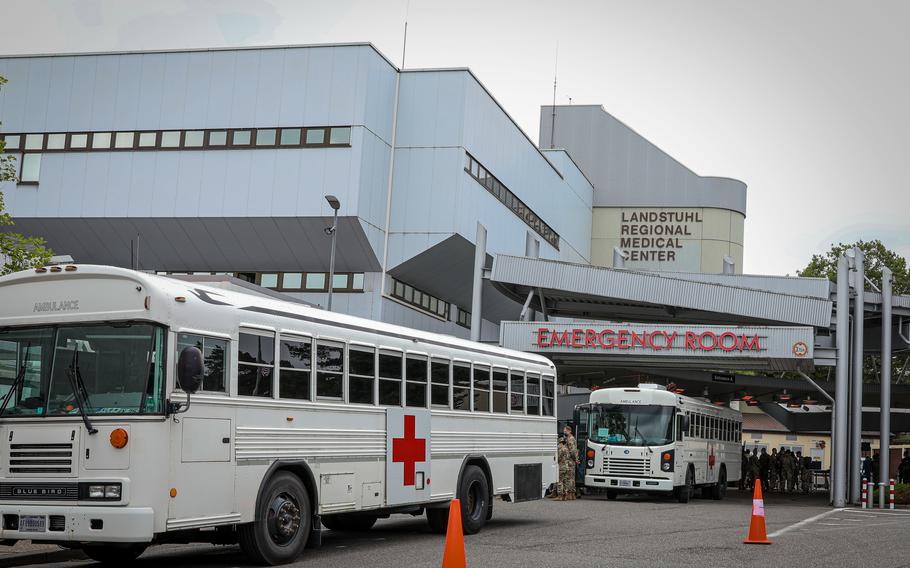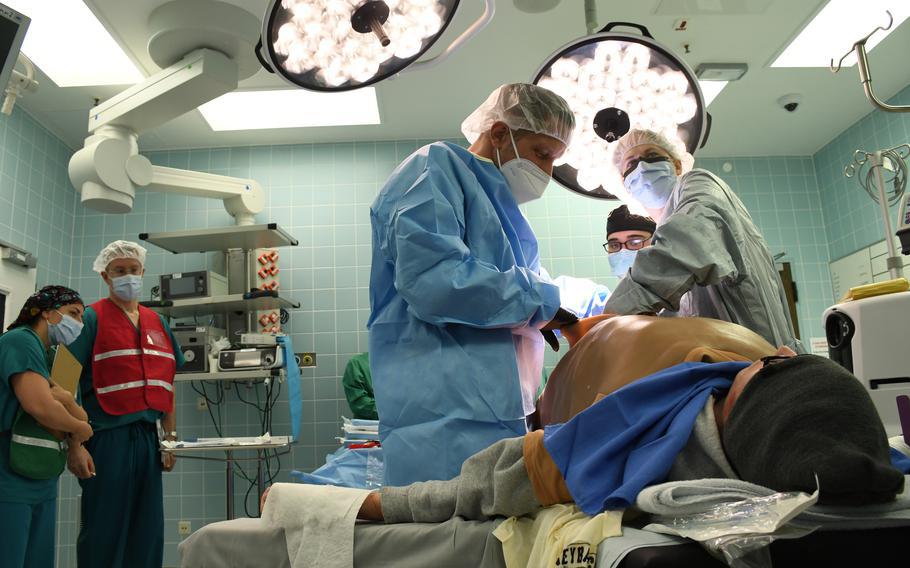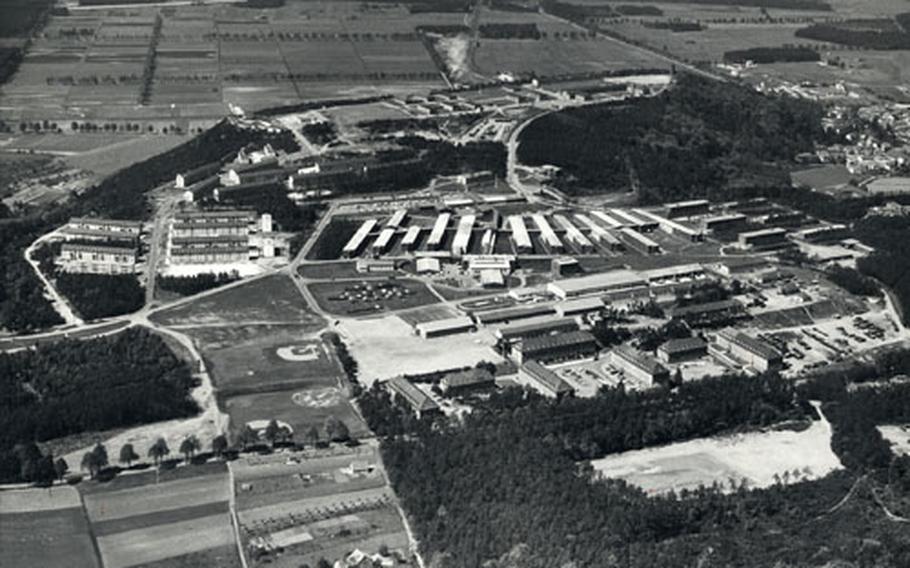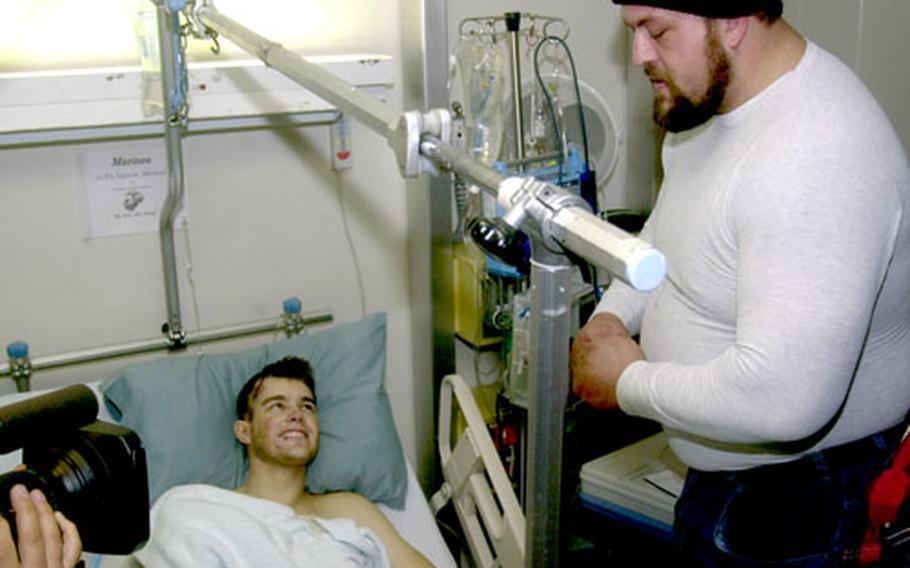
U.S. soldiers, airmen and civilian staff at Landstuhl Regional Medical Center receive patients who were medically evacuated from Kabul, Afghanistan, after U.S. service members and Afghan civilians were injured in a series of attacks outside of Hamid Karzai International Airport, Aug. 26, 2021. (Marcy Sanchez/U.S. Army)
LANDSTUHL, Germany — Landstuhl Regional Medical Center this month celebrates its 70th anniversary, but with construction of its replacement proceeding apace, the storied hilltop hospital is unlikely to have many more anniversaries in its future.
Work a few miles away on the $970 million Rhine Ordnance Barracks Medical Center is on schedule to be finished in 2027 and within its budget, hospital program officials said.
The new hospital will offer care to approximately 31,000 beneficiaries in the Kaiserslautern Military Community as well as specialty services to 209,000 others throughout Europe.
The transition has been in the making as early as 2010, when the military said that renovating and upgrading the old hospital would be too expensive. Excavators started clearing the forest near Ramstein Air Base for the new hospital in 2014.
Initial plans called for the hospital’s completion by 2022, but construction timelines have since been repeatedly revised. Today, the project is estimated to be 16% finished.

General surgeons Air Force Maj. Katherine Cameron, right, and Lt. Col. Joachim Sahm of the German military practice operating during a mass casualty response drill at Landstuhl Regional Medical Center in Germany, March 10, 2022. (Phillip Walter Wellman/Stars and Stripes)
With more than 968,000 square feet, the area of Rhine Ordnance Barracks Medical Center will exceed LRMC’s by roughly 218,000 square feet, or almost four football fields.
The new hospital will feature nearly the same number of beds, 68, but 25 more can be added in emergencies. It is expected to employ roughly 2,500 people, similar to the staff size at LRMC.
The ongoing Russia-Ukraine war on NATO’s eastern front underscores the importance of having a wide-ranging care provider on the Continent, military health care officials said. The hospital has treated Ukrainian soldiers wounded in the fighting over the past year.
“The new facility will decrease transportation times for critically injured patients medevaced through Ramstein from more than 20 minutes to just five minutes,” hospital spokesman Marcy Sanchez said. “It’s also a more secure path of transportation.”
The Rhine Ordnance Barracks facility will be able to shift focus to wartime care as required to treat battlefield injuries or handle mass casualties for troops deployed in Europe, Africa and the Middle East, officials said.
Ramstein’s 86th Medical Group will combine its operations with those of the new facility. Details of the merger “are just beginning to take shape,” David Fortune, a program manager, said Friday.
Both the hospital and the air base now share a gate, which is served by a lengthened road loop and a roundabout.

An artist’s rendering of the Rhine Ordnance Barracks Medical Center in Weilerbach, Germany, shows the wavy front that symbolizes a flag. A contract worth $970 million to complete the hospital, which replaces Landstuhl Regional Medical Center, was signed in 2022. (U.S. Army Corps of Engineers)
Although none of the new hospital’s buildings are finished, renderings of the complex’s design show a wavy facade intended to be reminiscent of a billowing American flag.
In addition to the nearly $1 billion construction contract, Germany is contributing more than $165 million to planning and construction supervision, according to the German Construction Administration.
About $200 million has already been spent on the construction and compensatory measures, such as tree replacements, prescribed by German nature conservation laws, according to German officials.
LRMC began as a humble Cold War-era community hospital in 1953.
A rise in worldwide terrorist acts against Americans in the 1980s led to an increase in its importance to the military. Service members injured in the bombing of the Marine Corps barracks in Beirut, Lebanon, in 1983, and the LaBelle disco bombing in Berlin in 1986 were treated there.
The first major local test for Landstuhl’s staff, however, came in 1988, when Italian jets collided during an air show at Ramstein, sending burning debris hurtling into the crowd of German and American onlookers. The hospital treated 500 people.
After the U.S. military drawdown in Europe following the Gulf War in 1991, clinics in Frankfurt, Wiesbaden and Nuremberg eventually closed, leaving Landstuhl as the largest overseas Defense Department medical facility.
During the wars that followed the 9/11 terrorist attacks, the hospital rapidly expanded its bed capacity and added the Deployed Warrior Medical Care Center to handle large numbers of casualties.
“There have always been events that challenged their team,” said retired Army Maj. Gen. David Rubenstein, who took command of the hospital as a colonel shortly before 9/11. “But usually these were one- or two-week events before going back to normal.
“What our team faced was going from a relatively sleepy, quiet regional-referral medical center to a 300-bed evacuation platform that didn't slow down over the long term.”

An undated file photo showing Landstuhl Regional Medical Center, Germany, before 2003. The medical center received updates over the years but is slated to be replaced by the all-new Rhine Ordnance Barracks Medical Center under construction near Ramstein Air Base. (Stars and Stripes)
For millions of Americans, Landstuhl became known as the evacuation point for airlifted soldiers and Marines with injuries from the battlefields of Iraq and Afghanistan.
Mike Larson, a former Marine, was cared for at LRMC in December 2005 after he was severely injured by a buried explosive in Fallujah, Iraq.
A member of the Wounded Warrior Project, Larson returned to the hospital grounds last week for his first visit since that stay more than 15 years ago.
“I received some of the best care here, including an experimental pain management system that was being tested at the time,” Larson said. “People here really are the best and know what they are doing.”
A Stars and Stripes front page from Dec. 6, 2005, shows Larson smiling in his hospital bed during a visit from WWE wrestler the Big Show.
Once LRMC gives way to its successor, the building and grounds will remain under the management of U.S. Army Garrison Rheinland-Pfalz, Sanchez said.
The old hospital facilities may continue to be used for logistical and administrative functions, Sanchez added.

WWE wrestler Big Show talks with Marine Corps Lance Cpl. Michael Larson on Dec. 6, 2005, at Landstuhl Regional Medical Center in Germany. Larson had been injured by a buried explosive in Fallujah, Iraq. (Stars and Stripes)